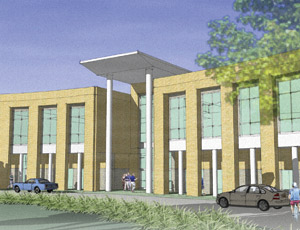The ongoing Southeast retrenchment for architectural and engineering services continued unabated in 2010, as evidenced by a further decline in the collective revenue represented by ENR Southeast's most recent Top Design Firms ranking. This year's ranking includes slightly more than $2.65 billion in collective 2010 revenue from projects located in the four-state region of Florida, Georgia and the Carolinas, down from last year's total of approximately $2.9 billion.

That total is a depressing reminder of the Southeast market's decline. Just two years ago, for example, the region's architects and engineers reported roughly $3.9 billion in revenue—almost 50% more than the current total.
Hoping for Recovery
Despite the dreary numbers, Southeast design firms are striving to remain at least cautiously optimistic about their future, but it's tough.
“We keep rubbing the crystal ball, and it's pretty cloudy,” says Willard Lariscy, managing director for Perkins+Will in Atlanta. “The certainty is not there.” Nor is the backlog, he adds, with this business barometer dwindling overall in the past year.
Of course, both architects and engineers are hoping to grow their backlogs, but that may not start to happen as soon as most firms would like. Instead, “still challenging and still slow” is how Michael Davila, principal with Johnson, Levinson, Ragan, Davila Inc., a building architectural firm in West Palm Beach, Fla., describes the current market for design services.
Health care holds the most promise for his firm, Davila adds, but too many opportunities are less than ideal. “We are looking at jobs we would have passed on in the past,” he says.
“We're seeing some positive signs,” says Mike Kroll, vice president with Miller Legg, the West Palm Beach-based planning firm. Most of those are coming from the public sector, he says, and mainly from institutional projects, rather than municipal.
Southeast Florida is the strongest region, he adds, with “good activity in the health-care and higher-ed sectors.” He estimates that over the past 12 months, Miller Legg has seen opportunities pick up by between 20% and 30% overall.

However, “competition is almost ridiculous at times,” he says, adding that some firms are continuing to slice fees to win contracts. “It's really not sustainable, but it's a way that firms are buying jobs. It's going to hurt us in the long run.”
Also, some public-sector owners seem to be developing unrealistic expectations. The intensely competitive bidding of recent years, paired with the reality of flat or declining construction budgets, has caused a few owners to demand what some in the industry feel are impossibly low prices.
Kroll cited a project in South Florida that most of the competing firms estimated at about $7 million. The public entity budgeted the job at $4.2 million, however, and when told by some of the competing firms that the price was unrealistic, officials responded by stating that they were sure that in these times some firm would give them that price. Kroll says Miller Legg was on four of the teams competing for that project, and all four opted against bidding the job.
“Probably 25% of the projects are like that,” he says, adding that many public entities are performing more early planning and design work in-house.
Also, designers indicate that while individual projects may move forward, often quickly, a green-lighted contract appears less like a market trend and more like an isolated incident.

“Compared to a year ago, there appears to be glimmers of activity, but it does not have the look of a general trend,” says Jim Posda, director of business development with GEL Engineering in Charleston, S.C. “Rather, they're focused projects that are being done to fill a specific need or have met funding requirements. The overall market is flat but indicating growth.”
In the current funding climate, “our clients can't plan as consistently,” adds Lariscy of Perkins+Will. “We have seen projects come out relatively quickly. We've got to be well-positioned and ready to move quickly, because the competition is fierce.”
The Numbers
The following ranking lists firms by the amount of 2010 design revenue generated from projects located in the four-state region of Florida, Georgia and the Carolinas. The main chart also includes market-sector breakouts for each firm, top regional officers and major projects.
Cumulative revenue is down by about $250 million overall compared with a year ago, and the decline starts at the top. The top 10 firms on this year's ranking reported $1.55 billion in revenue, down from last year's $1.71 billion. Of the top 10, only ARCADIS, HNTB Corp. and Perkins+Will reported improving fortunes.



Post a comment to this article
Report Abusive Comment